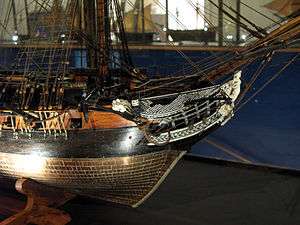Musée national de la Marine
 1/16-scale model of the Océan at the entrance of the museum | |
 Location within Paris | |
| Established | December 27th, 1827 |
|---|---|
| Location |
Palais de Chaillot |
| Coordinates | 48°51′43″N 2°17′15″E / 48.8620°N 2.2875°E |
| Type | maritime museum |
| Director | Vice Amiral Jean-Noël Gard |
| Public transit access | Trocadéro |
| Website | www.musee-marine.fr |
The Musée national de la Marine (National Navy Museum) is a maritime museum located in the Palais de Chaillot, Trocadéro, in the 16th arrondissement of Paris. It has annexes at Brest, Port-Louis, Rochefort (Musée National de la Marine de Rochefort), Toulon and Saint-Tropez. The permanent collection originates in a collection that dates back to Louis XV of France.
History
In 1748, Henri-Louis Duhamel du Monceau offered a collection of models of ships and naval installations to Louis XV of France, with the request that the items be displayed at the Louvre and made available to students of the Naval engineers school, which Duhamel headed. The collection was put on display in 1752, in a room of the first floor, next to the Academy of Sciences; the room was called "Salle de Marine" (Navy room), and was used for teaching.
With the French Revolution, the Salle de Marine closed in 1793. The collection was added to models owned by the King personally, to others owned by the Ministry of Navy, and yet others owned by émigrés or executees (notably Philippe Égalité). A short-lived museum was opened between 1801 and 1803 at the Ministry of Navy, then located at Place de la Concorde.

In 1810, Napoléon ordered a gallery of 19 models, known as the Trianon model collection, to be put on display in his offices at Grand Trianon, as to document the types of warships in usage in the French Navy at the time. Jacques-Noël Sané was put in charge of the task. Napoléon also had a model of the frigate Muiron in his bedroom at Château de Malmaison.
In 1827, after the Bourbon Restoration, Charles X ordered a Naval museum to be opened at the Louvre. The task was given to Pierre Zédé. Rooms were also opened or restored in Cherbourg, Brest, Lorient, Rochefort and Toulon.
In 1852, Antoine Léon Morel-Fatio became curator of the Museum. He emphasised the importance of painting, adding to the works of Joseph Vernet. He also made a catalogue of the items, and reorganised the ethnographic items of the collection.
In 1871, admiral François-Edmond Pâris became curator, and had over 400 models of small crafts indigenous to different locations of the French Empire constructed.
From 1905, ethnographic items were transferred to other museums, and in 1920, the administration of the Museum was transferred to the French Navy. In 1937, part of the Palais de Chaillot was devoted to harbouring the museum, which opened on 15 August 1943.
From 1971, the museum became an autonomous body under the Ministry of Defence. In 1975, it was instrumental in the restoration of Port-Louis fortress. In 1992, it purchased Éric Tabarly's Pen Duick V, now serving in the French Navy as a sailing school ship.
Gallery
-
Military themed metal plate exhibited in Musée national de la Marine.
-
Old weapons exhibited in Musée national de la Marine.
-
Neptune sculpture by Yves Collet exhibited in Musée national de la Marine.
-
Wooden Handcuffs exhibited in Musée national de la Marine.
See also
| Wikimedia Commons has media related to Musée de la Marine de Paris. |
Sources and references
External links
- Official museum website
- To know more about the Admiral François Edmond Paris and the exhibition which pay tribute to his work "All the boat of the world" the official virtual exhibition
- CARTES POSTALES ANCIENNES des Modèles et Objets du Musée national de la Marine Publiées de 1909 à 1939 environ quand le Musée était au Louvre
- Musée national de la Marine Visitor Information
| ||||||||||||||||||||||||||||||||||||||||||||||||||||||